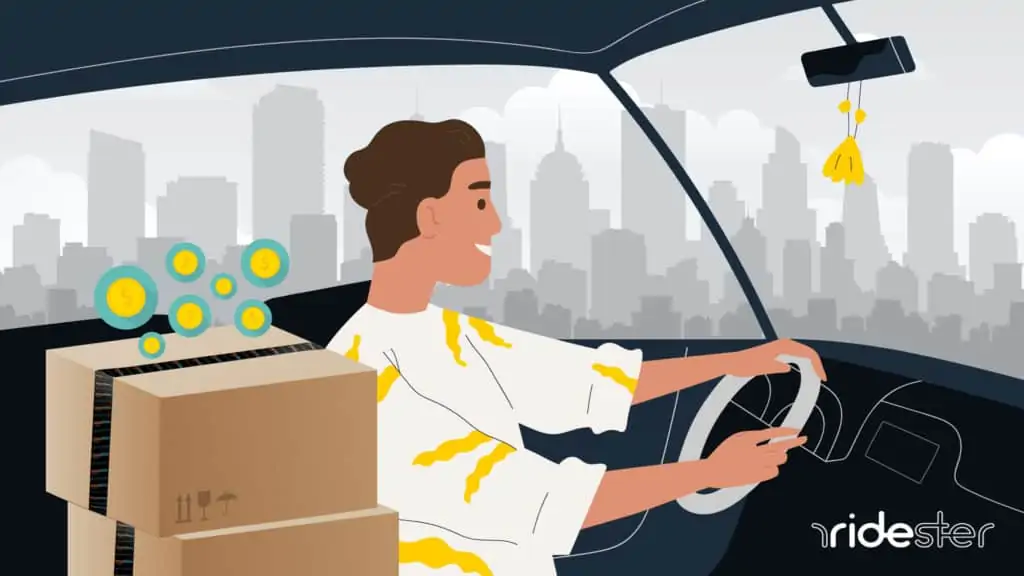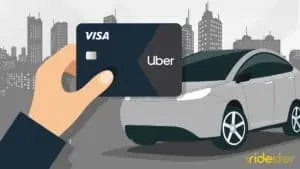Key Takeaways
- Amazon Flex drivers average $25.07 per hour, higher than many other gig delivery services.
- Typically earn $18 to $26 per trip, surpassing earnings from services like UberEats or DoorDash.
- Weekly average is $311.76, and monthly is around $823.05, ranking second after Uber drivers.
- Earnings are influenced by number of deliveries, efficiency, location, and seasons, with expenses like fuel and maintenance impacting net income.
With the rise of the gig economy, many Americans have taken up app-based delivery driving as a means of earning extra income (or even as full-time work).
One of the most well-regarded of these delivery services is Amazon Delivery!
Amazon Delivery driving can be a great opportunity to earn money with only a few limited requirements.
Namely, you’ll need a vehicle and the ability to pass the entry requirements. After that, you can start making deliveries!
But before you jump in and become an Amazon driver, you may be curious as to how much they make. In this article, we’ll discuss:
- The Amazon Delivery network
- Hourly, weekly, and monthly earning averages of Amazon drivers compared to other services
- A breakdown of the Amazon Delivery payment structure
- Other factors and expenses to consider.
Let’s dive right in.
- Are Amazon Drivers Employees or Contractors?
- How Much Do Amazon Drivers Make?
- Hourly Earnings Across Platforms: The Data
- Understanding Amazon’s Payment Structure
- Other Factors Influencing Earnings
- Net Earnings: What to Really Expect
- What is the Wage-Theft Lawsuit Against Amazon for 8.2 Million?
- Amazon Delivery Driver Benefits
- Amazon Flex Driver Expenses
- Frequently Asked Questions
- The Bottom Line
Are Amazon Drivers Employees or Contractors?
Amazon drivers can be either full-time or part-time employees working for Delivery Service Partners (DSPs), which are independent entities that assist with Amazon’s “last mile” deliveries.
Additionally, some drivers operate as independent contractors through the Amazon Flex program, which requires them to use their own vehicles and cover related expenses.
Thus, depending on their association, Amazon drivers can be either employees or contractors.
Understanding the Pay Structure
Amazon pays its drivers based on their specific role.
DSP drivers receive an hourly wage, which can include potential tips and promotions. These drivers have their vehicle and other expenses covered by Amazon and work on regular schedules.
On the other hand, Amazon Flex drivers are compensated per delivery block they sign up for through the Flex app.
While they might have the potential to earn more per hour compared to DSP drivers, they must cover their own vehicle expenses.
Pay Structure (At a Glance)
DSP drivers: Paid hourly, with potential for tips and promotions. They get vehicles and other expenses covered, enjoying regular schedules.
Flex drivers: Paid per block they sign up for, as indicated on the Flex app. They may earn more per hour than DSP drivers but bear their vehicle’s expenses.
In essence, while DSP drivers are paid by the hour regardless of deliveries, Flex drivers earn based on each delivery block or trip they complete, with the added responsibility of their own vehicle costs.
How Much Do Amazon Drivers Make?
Amazon drivers’ earnings vary based on their roles, location, and entrepreneurial efforts.
Standard Amazon Drivers: Consistent Pay and Stability
Standard Amazon drivers, who predominantly work for Delivery Service Partners (DSPs), don’t work directly for Amazon but still form the backbone of its delivery network. Their financial benefits include:
- A guaranteed minimum wage of $15 per hour.
- Potential for higher earnings based on experience and location.
- Steady income due to their status as traditional employees.
Amazon Flex: The Gig Economy Meets Amazon
Amazon Flex provides a more flexible approach to deliveries. Flex drivers:
- Choose their shifts via the Amazon Flex app.
- Are paid a flat rate per delivery block.
- Can earn between $18 to $25 per hour, although they must account for additional expenses due to their contractor status.
Regional Variations in Pay: Where You Work Matters
Location plays a pivotal role in determining earnings. For instance, in San Francisco, Amazon driver job listings often start at $20 per hour. However, New York-based drivers can expect starting wages of around $17 per hour.
Even within states, earnings can vary.
In Hawaii, where the hourly rate can reach nearly $19, a full-time driver might earn about $150 daily.
In Ohio, with an average rate of approximately $18.67 per hour, weekly earnings could sum up to roughly $747, which equates to just over $3,200 monthly.
For potential drivers, understanding these regional nuances can be instrumental in determining where to work.

Beyond Deliveries: The World of DSP Ownership
Amazon’s drive to create a comprehensive logistics network has paved the way for unique entrepreneurial opportunities, one of which is the DSP fleet ownership.
By making a modest personal investment, enterprising individuals can venture into owning and managing their own fleet of Amazon delivery vans.
Amazon lends a hand by providing the vans, along with the essential training and information to jumpstart the operation. A standard fleet usually starts with at least 10 vans, though it’s not uncommon to see fleets boasting 20 to 40 vans.
Like any business, DSP fleet ownership comes with its risks and success isn’t a given.
But for those who navigate the challenges effectively, the financial rewards can be significant, with top fleet owners potentially earning up to $300,000 a year.
Top-Earning Cities for Amazon DSPs
If you’re wondering where to set up or work for a DSP, consider these top-earning cities:
- Sunnyvale, California, tops the list with an average annual salary of $76,254.
- Santa Cruz, California, follows closely at $75,549.
- Santa Rosa, California, isn’t far behind with $73,840.
- Williston, North Dakota, offers an attractive average of $72,357 annually.
- Manhattan rounds off our top five with an impressive $72,168.
Hourly Earnings Across Platforms: The Data
Amazon Delivery isn’t the only delivery game in town, and depending on your needs and capabilities, there is a wide variety to choose from.
With that being said, the bottom line is a key factor in deciding which service you should sign up for.
Based on national averages, Amazon Flex drivers earn $25.07 per hour worked, putting them at the top spot. Just below, at $22.96, Uber drivers ferry customers about town.
Instacart, Uber Eats, and DoorDash drivers earn $16.45, $16.37, and $13.55 per hour respectively.
Earnings Per Trip
Given that your hours are spent delivering goods as an Amazon Flex driver, it can be useful to know how much each trip is worth to you in earnings.
These rates do fluctuate based on the time the trip takes place and the duration, but based on national averages we know:
- Amazon Flex drivers can earn between $18 to $26 depending on the variables discussed above
- Instacart Drivers earn on average $15.51 per trip. Uber drivers earn $12.70 per trip, and UberEats and DoorDash drivers earn on average $8.75 per trip and $7.78 per trip respectively.
From these numbers, we can see that other services have to perform more deliveries in an hour to match the Amazon Flex per-trip earnings.
Weekly Earnings Per Platform
Weekly earnings are measured based on the average driver’s overall earnings per week and take into account variable hours and the distinction between full and part-time drivers.
It is also worth noting that Amazon Flex drivers book blocks of hours out, so their minimum earnings are set per block booked.
Here are the weekly earning averages for each app:
- Uber: $423.63/week
- Amazon Flex: $311.76/week
- Doordash: $199.36/week
- Instacart: $196.85/week
- UberEats: $170.31/week.
We can see that week over week, Uber drivers on average earn more than their Amazon Flex counterparts.
Monthly Averages
The monthly averages of different delivery drivers are similarly calculated based on national average earnings numbers. The same variables are at play with these numbers as others.
- Uber: $1,136.47/month
- Amazon Flex: $823.05/month
- Doordash: $535.77/month
- Instacart: $499.76/month
- UberEats: $431.38/month.
Similarly to the weekly earnings averages, Uber drivers are the highest earners month over month, with Amazon Flex drivers coming in second.
Understanding Amazon’s Payment Structure
Amazon Flex has a payment structure different from most other apps. The key factors are minimum contributions guaranteed by Amazon, the booking of hours, and 100% of tips kept by drivers.
- Base Compensation: Amazon guarantees all flex drivers a base return on their hours booked. Depending on where they are located and what time the hours take place, that rate varies from $15.00 to $19.00 an hour.
- Incentives and Bonuses: Amazon Flex drivers are granted access to a wide variety of perks and benefits through Amazon Flex Rewards. These include cashback on Amazon purchases, preferential scheduling, and thousands of discounts on Amazon products. Flex Rewards points are earned simply by making deliveries.
- Tips: Amazon Flex drivers retain 100% of tips given to them by customers. Amazon does not ever take a cut! Handily, Amazon provides tip data to drivers when they schedule a delivery block based on recent trips to that area and the tips received for those trips.
- Block Rates: Because Amazon Flex drivers schedule blocks of hours to work, those blocks are assigned different guaranteed pay rates based on time, location, distance, and other variables. The base pay guaranteed by Amazon will never drop below $15.00 per hour, however.
Other Factors Influencing Earnings
While the standard hourly, weekly, monthly, and per-trip earnings averages give a good indication of how much you stand to earn as an Amazon Flex delivery driver, there are other factors to take into account when assessing your potential earnings:
Number of Trips
Delivery drivers earn more when they have more deliveries to make because they are more likely to collect more tips!
If you have an hour with 25 deliveries to make, you stand to earn a lot more than during an hour with only 10 deliveries. Be sure to factor this into your estimations.
Seasonal Fluctuations
People are more likely to have things delivered when going out to collect them is a hassle or particularly unpleasant.
For this reason, the height of summer or cold winter often sees more people needing projects to be delivered in order to save themselves the trip. This means that there is some seasonal variability in your earnings.
Efficiency and Speed
The more efficient you are, the more trips you can perform in your allotted Amazon Flex block.
Further, the more prompt and efficient your deliveries are, the better feedback you will get from customers (and the more highly regarded you will be).
Delivery Locations
Drivers earn more based on location-based demand. The highest-earning metro areas are as follows:
- Amazon Flex: Seattle, Chicago, LA, San Francisco, Atlanta
- Doordash: New York, Atlanta, Seattle, San Francisco, Dallas
- Instacart: Seattle, Atlanta, LA, New York, Chicago
- Uber: New York, Seattle, LA, San Francisco, Miami
- Uber Eats: San Francisco, Seattle, New York, LA, Chicago.
Net Earnings: What to Really Expect
You have to pay taxes and deduct operating costs from your earnings as an Amazon Flex driver.
The benefit is that you have a guaranteed pay rate based on the blocks you schedule, so you will always have a minimum amount to make these important operational deductions from.
All things being equal, it is important to understand these costs and factor in the reality of net earnings as opposed to reading solely into gross income potential.
What is the Wage-Theft Lawsuit Against Amazon for 8.2 Million?
The suit, which was brought against Amazon and some of its DSPs in 2017, came from two drivers.
They issued a complaint that Amazon and their delivery partners made the drivers work without lunch breaks to deliver the required number of packages each day, and they were never paid for those missed breaks.
Other drivers eventually came forward and alleged similar working situations in their areas, some of them claiming that they felt such pressure that they wouldn’t stop even for bathroom breaks.
While the intermediary delivery partners were the direct employers of these drivers, Amazon was accused of culpability for their refusal to address the issues facing employees who drove Amazon vans and wore Amazon uniforms.
In March 2021, the parties involved agreed to an $8.2 million class-action settlement.
Amazon Delivery Driver Benefits
As a full-time delivery driver for Amazon, you are eligible for employee benefits which often extend to your eligible family members.
These perks notably include:
- Health coverage: You will get to choose from several health insurance plans, which include some prescription drug coverage and a Health Savings Account (HSA). If desired, you can also choose from a selection of dental and vision plans. Full-time drivers also qualify for free nurse consultations (or discounted doctor consultations) on a 24/7 medical advice line.
- Paid time off: All employees accrue PTO throughout the year. If you choose not to take eligible holidays off, you can earn time and a half. Maternal and paternal leave options are also available.
- Financial security plans: Full-time drivers are eligible for Amazon’s 401(k) plan, life insurance, and short-term and long-term disability pay.
- Other financial support: Amazon assists with eligible adoption fees and provides annual discounts for Amazon.com orders.
Most DSPs also promise competitive benefits in their job listings, so you can still expect great perks even if you don’t work directly for Amazon.
Amazon Flex Driver Expenses
On the flip side, Amazon Flex drivers are never eligible for benefits. As a contractor, you’re legally considered your own boss. That means you must pay for your own time off, insurance needs, and more.
Here, we’ll describe some of the expenses Flex drivers cover:
- Vehicle expenses: Whereas standard delivery drivers work from company-supplied cargo vans, Flex drivers work from their own vehicles. This means you can expect to pay more for your car maintenance needs like oil changes and gas.
- Car insurance: If you use a separate car for your Amazon Flex gig, you’ll need to budget for a new car insurance policy as well as registration fees and car loan payments.
- Self-employment taxes: As is standard across the gig economy, Amazon contractors can expect to pay 15.3% of their income in Medicare and Social Security taxes on top of their income taxes for other revenue streams. Part-time and full-time Amazon drivers, on the other hand, only pay 7.65%. This is because they have a separate employer to cover the other half, whereas contractors are their own employers.
On the plus side, your hourly earnings will almost always be higher than standard Amazon driver wages.
Plus, you can choose to work during your free time. This flexibility may make the responsibilities that come with the Flex gig worth it for you.
Most Amazon Flex driver expenses are also tax-deductible.
So as long as you log your receipts and mileage, your annual taxes may not be as high as you’d expect.
Frequently Asked Questions
Do you get paid for Amazon delivery driver training?
Yes, Amazon offers paid training and orientation. Flex drivers have a different situation, however. There are a series of videos to watch through the Flex app, and they are not paid for that time.
Do Amazon delivery drivers have to pay for their own parking tickets?
Amazon Flex drivers cover their own work-related expenses, including parking tickets. For drivers working with Delivery Service Partners (DSPs), the policy on parking tickets varies by location; some DSPs may pay for tickets, while others require drivers to pay.
However, parking tickets are issued to the vehicle’s owner and won’t affect the driver’s record.
How many Amazon delivery partners are there?
While Amazon does not have a published list of its DSPs and their drivers, we do know that they currently have over 1,700 delivery partners out there.
Amazon driver pay is highly competitive, often exceeding the earnings of Uber and Lyft drivers. While Lyft drivers average around $17.50 per hour, which is higher than most rideshare drivers, this figure falls below the lower end of Amazon Flex driver earnings, especially after accounting for rideshare expenses.
The Bottom Line
For dedicated, full-time drivers in one of the top 5 metro areas for Amazon Flex, being an Amazon Flex driver is a great opportunity to work flexible hours, enjoy good earnings, benefit from great perks, and have a guaranteed minimum income.
In less in-demand areas (or any area with lower average earnings), Amazon Flex could still be a great full-time job provided the cost of living is low enough.
In any case, Amazon Flex pays the most per trip and per hour of any delivery app as part-time supplementary work. Therefore, it may be the perfect opportunity to help you reach your financial goals or supplement your regular earnings!
If you’re undecided about driving for Amazon but are open to delivery jobs, you might want to explore opportunities with food delivery apps, like becoming a Postmates driver.






Hello, yes, Amazon Flex pays $18 to $25 per hour, since I have started, Summer of 2021. It is never less than $18, you can pick your schedules by live-running offers in their app. But the lowest is $18, with the price of gas, many try to wait for it to go up. I never take a shift for less than $22/hr. Even tho we’re IC’s, we still get told what to do, have to arrive on time or not be paid, and are managed as if we were their real employees. No co-workers tho.
I’ve seen a few go from Flex, to Employee, then back to Flex. Those warehouse workers are definitely overworked. Sometimes my deliveries take me PAST when I’m paid for, instructions say to return them to the depot, which could be 30 miles away and you will get marked down for “non delivery” if you do that.
Great article.
Sorry but Amazon drivers on the east coast do not receive any benefits of life insurance, no disability insurance or 401K